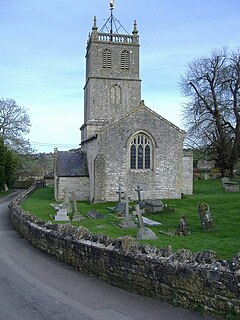Priston
| Priston | |
|---|---|
 | |
Location within Somerset | |
| Population | 232 [1] |
| OS grid reference | ST694605 |
| Unitary authority | |
| Ceremonial county | |
| Region | |
| Country | England |
| Sovereign state | United Kingdom |
| Post town | BATH |
| Postcode district | BA2 |
| Police | Avon and Somerset |
| Fire | Avon |
| Ambulance | South Western |
| UK Parliament | |
Priston is a civil parish and village 4 miles (6 km) south west of Bath in Bath and North East Somerset, which is within the English ceremonial county of Somerset. The parish includes the hamlet of Wilmington.
History
[edit]A walled field boundary, which marks the boundary between the manor of Priston village and the former manor of Wilmington hamlet contains megaliths, indicating it may have been a boundary in pre-historic times.[2]
Priston is the site of a Roman villa dating from about 100 AD. A coffin from this site was discovered in 1917.[3]
Around 925 the manor of Priston was given by king Æthelstan to Bath Abbey.[4]
The parish of Priston was part of the Keynsham Hundred,[5]
The village is recorded in the Domesday Book as including the presence of a church, possibly wooden; however the nave of the Church of St Luke and St Andrew was added in the 12th century, and the church has a tower dating from the 15th century. It has been designated by English Heritage as a Grade I listed building.[6] It is crowned with a disproportionately large weather vane given as a gift by the lord of the manor in 1813.[7]
The manor was held by the Prior of Bath Abbey until the dissolution of the monasteries, passing into the hands of the laity. From the 18th century to 20th centuries it was held by the Jenkins family.[4]
Priston Mill was given by the monks of Bath Abbey in 931. It is powered by a 25 feet (8 m) overshot water wheel.[7] The present building dates from the late 18th or early 19th century and is maintained in working condition.[8] The associated tithe barn was built around 1700 and is currently used as a wedding and conference venue.[9]
Priston was in Keynsham Poor Law Union, with records showing it had a population of 292 in 1861, including the hamlet of Wilmington.[10]
Priston was the site of a mine on the Somerset coalfield. The mine closed in 1930.
Governance
[edit]The parish falls within the unitary authority of Bath and North East Somerset which was created in 1996, as established by the Local Government Act 1992. Before 1974 the parish was part of the Bathavon Rural District.[11]
The parish is represented in the House of Commons of the Parliament of the United Kingdom as part of Frome and East Somerset.[citation needed]
References
[edit]- ^ "Priston Parish". Neighbourhood Statistics. Office for National Statistics. Archived from the original on 1 January 2014. Retrieved 31 December 2013.
- ^ World Heritage Site Setting Study rev4 current 22-10-09 WEB VERSION PART 5 (PDF), Bath and North East Somerset Unitary Authority, archived from the original (PDF) on 15 January 2011
- ^ "Roman coffin". Priston village website. Retrieved 5 July 2007.
- ^ a b Robinson, W.J. (1915). West Country Churches. Bristol: Bristol Times and Mirror Ltd. pp. 120–124.
- ^ "Somerset Hundreds". GENUKI. Retrieved 15 October 2011.
- ^ "Church of St Luke and St Andrew". historicengland.org.uk. English Heritage. Retrieved 14 August 2008.
- ^ a b Scott, Shane (1995). The hidden places of Somerset. Aldermaston: Travel Publishing Ltd. p. 22. ISBN 1-902007-01-8.
- ^ "Priston Mill and attached pond, dam and walls". historicengland.org.uk. English Heritage. Retrieved 14 August 2008.
- ^ "The History of Priston Mill". Priston Mill. Archived from the original on 25 April 2008. Retrieved 14 August 2008.
- ^ "Parliamentary papers", books.google.co.uk, vol. 49 (2 ed.), 1861, retrieved 12 March 2011
- ^ "Bathavon RD". A vision of Britain Through Time. University of Portsmouth. Retrieved 4 January 2014.
External links
[edit]- Map of the parish on Google Maps
- Village Website
- Priston Village Design Statement (PDF) (Report). Bath and North East Somerset Council. 16 May 2018.


 French
French Deutsch
Deutsch